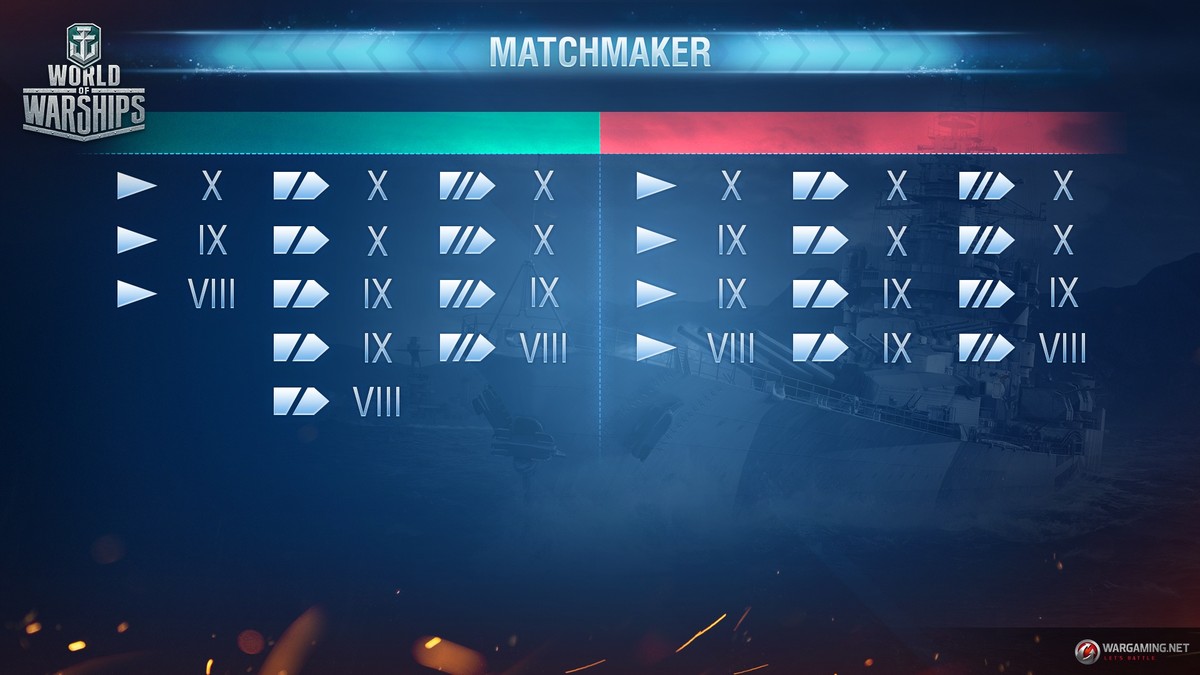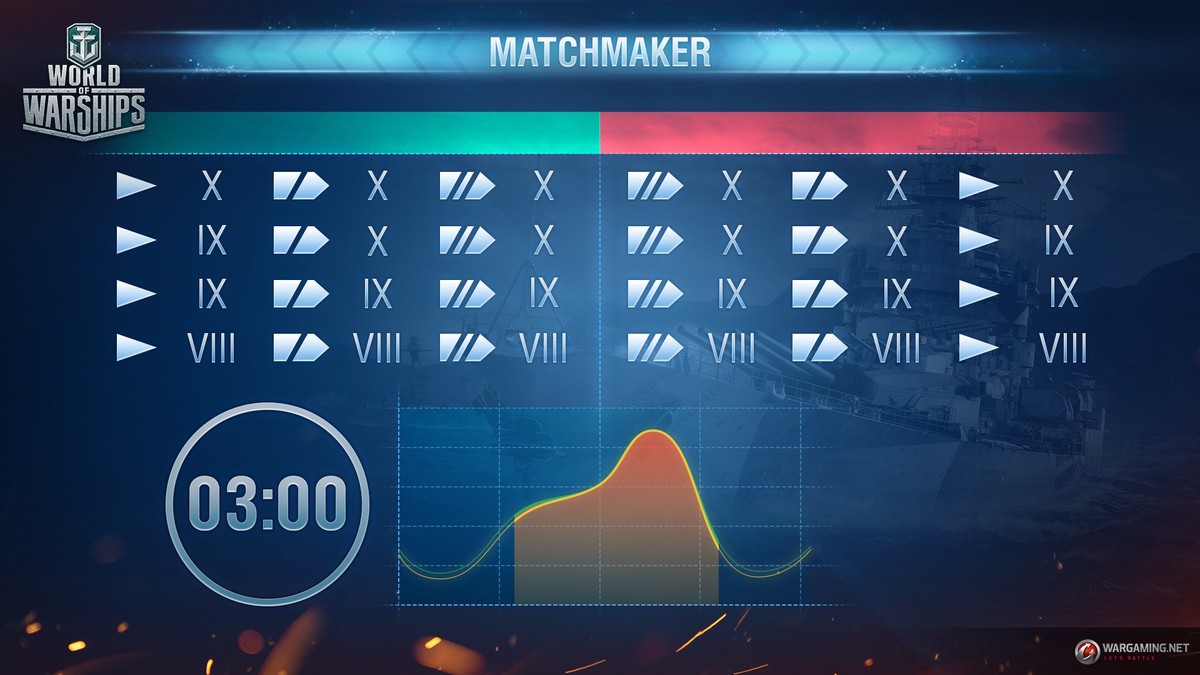How it Works
Greetings, Captains!
As Update 0.7.4 draws near, let’s take a closer look at what you get once it goes live. The new episode of Developer Diaries will tell you how we worked on Ranked Battles Season 9 and what it took to recreate Port Kronstadt. We also go into the changes we made to the system for the prevention of and punishment for unsportsmanlike conduct and unfair play, as well as how we tweaked the matchmaker.
Enjoy our new video, and check out the extra info on the changes to the matchmaker below. This issue is of paramount importance to us so we’ll zero in on it a bit more.
Subtitles in our supported languages are also available by clicking on the icon in the bottom-right corner.
Changes to the Matchmaker in Update 0.7.4
The matchmaker is an algorithm that picks players from the queue and divides them up into teams. The primary task of the matchmaker is to ensure the maximum possible quality of matching teams for a battle within the shortest possible period of time. In the majority of cases, the matchmaker does it well. However, there are situations when teams DO have equal chances to win but have lineups that differ slightly by ship types and tiers, which could sometimes cause discomfort among players.
The main change to the matchmaker to be introduced when Update 0.7.4 hits the live servers will affect the way the matchmaker works during the first three minutes of time spent in the queue for a battle. Now, when the first player is queued for a battle, for three minutes the matchmaker will try to strictly mirror team lineups by ship types and tiers. This way the system will operate most efficiently when a sufficient number of players are queued for a battle.
If the matchmaker fails to assemble a battle during the three minutes that the first player in the queue spends waiting to enter a battle, it will revert to its previous, pre-Update 0.7.4 operation mode because at that moment sending queued players into battle as soon as possible is more important than trying to achieve mirrored team lineups. This scenario is more likely to happen late at night and during early morning hours when server population is relatively low.
Please bear in mind the “standard” principles of matchmaking, which are used now and will continue to be used after Update 0.7.4, goes live in scenarios when the queue time exceeds the above-mentioned three-minute period:


- First of all, matchmaking depends on the number of available players. Even “understaffed” teams (11v11, 10v10, etc.) may sometimes be matched into battle.
- The number of maximum-tier ships in teams is always strictly symmetrical. If in a Tier X battle one team has two Tier X battleships, three cruisers and one destroyer, this lineup will be strictly mirrored on the opposing team. The same rule applies to battleships that are one tier lower than the tier of the battle. If one of the teams has one Tier IX battleship in a Tier X battle, the other team will have only one such battleship, too. Aircraft carriers are distributed between teams strictly symmetrically.
- The matchmaker tries to ensure the equal distribution of ships by types on both teams but sometimes a minor deviation from this rule is possible depending on the type of ships. For instance, one team may have one destroyer or battleship, or up to two cruisers more than the other.
- Moreover, the matchmaker takes into account the nation that every ship belongs to but nation-based distribution of ships between teams is done irrespective of their tiers. The matchmaker tries to make national representation on opposing teams as equal as possible. In doing so, it tries to place ships on teams by their tier, type and nation evenly but not strictly symmetrically. If the system always adhered to strict lineup symmetry, the time players would spend in the queue for a battle might exceed five minutes, and the teams would be sent into battle understaffed.
For example:
One of the teams may have two Tier X battleships ![]()
![]() X Yamato , one
X Yamato , one ![]()
![]() IX Iowa and one
IX Iowa and one ![]()
![]() VIII Bismarck . The opposing team will strictly have two Tier X and one Tier IX battleships (e.g., two battleships—
VIII Bismarck . The opposing team will strictly have two Tier X and one Tier IX battleships (e.g., two battleships—![]()
![]() X Montana and
X Montana and ![]()
![]() IX Izumo ) but will not necessarily have a Tier VIII battleship. This example demonstrates that both teams have Japanese and U.S. ships. The place of the fourth battleship may be filled with, for example, a German cruiser
IX Izumo ) but will not necessarily have a Tier VIII battleship. This example demonstrates that both teams have Japanese and U.S. ships. The place of the fourth battleship may be filled with, for example, a German cruiser ![]()
![]() VIII Admiral Hipper or
VIII Admiral Hipper or ![]()
![]() VIII Z-23 .
VIII Z-23 .
We’d like, once again, to draw your attention to the fact that with the release of Update 0.7.4, the above-mentioned basic principles will only come into effect if the first player queued for battle spends more than three minutes in the queue.
The enhanced matchmaker will make naval battles more comfortable for most players, reducing distractions and the need to assess team lineups.
Join the journey into the dangerous waters of World of Warships!
Come funziona?
Salve, Capitani!
Diamo un’occhiata più da vicino alle novità introdotte dall’imminente aggiornamento 0.7.4. Il nuovo episodio dei Diari degli sviluppatori analizzerà il nostro lavoro sulla 9ª stagione di Battaglie Classificate, sulla ricreazione del Porto di Kronstadt, sulle modifiche effettuate al sistema di prevenzione e le relative punizioni per condotta antisportiva e gioco sleale e, infine, sul nuovo matchmaking.
Godetevi il nostro nuovo video e leggete il seguente approfondimento sulle modifiche al matchmaker. Questo problema è di essenziale importanza per noi, pertanto lo approfondiremo nei minimi dettagli.
Per le lingue supportate sono disponibili anche i sottotitoli: basta fare clic sull’icona nell’angolo in basso a destra.
Modifiche al matchmaker con l’aggiornamento 0.7.4
Il matchmaker è un algoritmo che seleziona i giocatori da una coda e li divide in squadre. Il suo compito principale è assicurare il massimo equilibrio possibile tra le squadre di una battaglia nel minor tempo possibile. Nella maggior parte dei casi ottiene ottimi risultati. Tuttavia, si possono verificare situazioni in cui le squadre HANNO le stesse probabilità di vittoria ma schieramenti differenti in quanto a tipologie e livelli delle navi, causando quindi disagi tra i giocatori.
La modifica principale al matchmaker verrà introdotta con l’arrivo dell’aggiornamento 0.7.4 nei server principali, evento che ne altererà il modus operandi nei primi tre minuti di coda. Adesso, quando il primo giocatore entra in coda, i primi tre minuti il matchmaker tenta di abbinare le squadre rigorosamente per tipo e livello delle navi. Con questo metodo, il sistema dà il suo meglio solo con un consistente numero di giocatori disponibili.
Il matchmaker torna a operare secondo le modalità pre-aggiornamento 0.7.4 se non riesce a creare la battaglia entro tre minuti dal momento in cui il primo giocatore è entrato in coda. Riteniamo che al momento sia più importante fare in modo che i giocatori possano entrare in battaglia il più rapidamente possibile piuttosto che cercare di ottenere delle squadre perfettamente simmetriche. Questa eventualità si verificherà più spesso di notte e alla mattina presto, quando i giocatori connessi sono relativamente pochi.
Tenete bene a mente che le regole “standard” di matchmaking attualmente in uso rimarranno valide in seguito all’introduzione dell’aggiornamento 0.7.4 quando il tempo di attesa supera il sopra menzionato periodo di 3 minuti:


- Innanzitutto, il matchmaking dipende dal numero di giocatori disponibili. In qualche caso potrebbero essere create partite costituite da un numero inferiore di giocatori (11v11, 10v10, ecc.)
- Il numero di navi di massimo livello in ogni squadra è sempre simmetrico. Se all’interno di una battaglia di livello X una squadra è composta da 2 corazzate di livello X, tre incrociatori di livello X e un cacciatorpediniere di livello X, questo schieramento viene adottato anche per l’altra squadra. La stessa regola si applica alle corazzate di un livello inferiore rispetto al livello della battaglia. Se una delle squadre ha una corazzata di livello IX in una battaglia di livello X, anche l’altra squadra avrà una corazzata di tale livello. Le portaerei vengono distribuite tra le squadre in maniera strettamente simmetrica.
- ll matchmaker prova a garantire un’uguale distribuzione dei tipi di nave in entrambe le squadre, ma a volte questa regola può essere leggermente derogata, in base al tipo delle navi. Ad esempio, una squadra potrebbe avere un cacciatorpediniere o una corazzata in più, oppure uno o due incrociatori in più.
- Inoltre, il matchmaker considera la nazione di appartenenza di ogni nave, ma la distribuzione delle navi nelle squadre in base alla nazionalità viene fatta indipendentemente dal livello. Il matchmaker cerca di bilanciare il più possibile la rappresentazione delle nazioni all’interno delle squadre. Facendo ciò, cerca di distribuire le navi nelle squadre in base al livello, al tipo e alla nazione in modo uniforme, ma non in modo strettamente simmetrico. Se il sistema dovesse sempre rispettare una simmetria assoluta, il tempo trascorso in coda da parte dei giocatori potrebbe essere superiore ai cinque minuti e le squadre entrerebbero in battaglia con pochi giocatori.
Ad esempio:
Una delle squadre potrebbe avere due corazzate ![]()
![]() X Yamato di livello X, una
X Yamato di livello X, una ![]()
![]() IX Iowa (IX) e una
IX Iowa (IX) e una ![]()
![]() VIII Bismarck (VIII), mentre l’altra squadra potrebbe ritrovarsi con solo due livelli X e una corazzata di livello IX, ad esempio due corazzate
VIII Bismarck (VIII), mentre l’altra squadra potrebbe ritrovarsi con solo due livelli X e una corazzata di livello IX, ad esempio due corazzate ![]()
![]() X Montana (X) e una
X Montana (X) e una ![]()
![]() IX Izumo (IX), ma senza alcuna corazzata di livello VIII. Questo esempio dimostra che entrambe le squadre hanno navi giapponesi e americane. Il posto della quarta corazzata potrebbe essere preso da un incrociatore tedesco
IX Izumo (IX), ma senza alcuna corazzata di livello VIII. Questo esempio dimostra che entrambe le squadre hanno navi giapponesi e americane. Il posto della quarta corazzata potrebbe essere preso da un incrociatore tedesco ![]()
![]() VIIIAdmiral Hipper , ad esempio, o dal cacciatorpediniere
VIIIAdmiral Hipper , ad esempio, o dal cacciatorpediniere ![]()
![]() VIII Z-23.
VIII Z-23.
Di nuovo, vorremmo richiamare la vostra attenzione sul fatto che con il rilascio dell’aggiornamento 0.7.4, i principi base riportati sopra funzionano solo se il tempo trascorso in coda per la battaglia dal primo giocatore supera i tre minuti.
Il matchmaker migliorato renderà le battaglie navali ancora più godibili per la maggior parte dei giocatori e ridurrà il tempo speso a valutare gli schieramenti delle squadre.
Le acque tempestose e gli scontri navali di World of Warships vi attendono!
Ai posti di combattimento!
